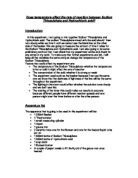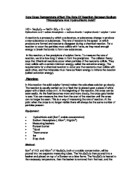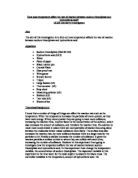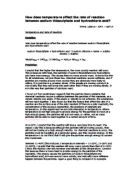David Macmillan Science 1 Investigation Chemistry 11Q7 SSW
Centre number: 49051
Candidate number:
How does temperature affect the rate of reaction between
Hydrochloric acid and sodium thiosulphate solution
Prediction
The prediction for this experiment is that when the temperature increases the time taken for the reaction to complete will decrease. I believe this will happen because of the collision theory. This states that when particles have more energy they collide more often and much harder and the reaction occurs at a faster rate. This can be done by increasing the temperature, concentration or surface area and also by adding a catalyst. In this experiment the temperature is the variable factor each time and as it increases the particles gain more energy to collide more often therefore increasing the rate of reaction.
Results
Analysis
These results show that as the temperature increases the rate at which the reaction occurs also increases. This is shown by the time taken for the reaction to complete getting shorter as the starting temperature increases. The table above showing a higher rate of reaction as the temperature increases also proves this. And this comes from the collision theory suggesting that when particles have a higher temperature, larger surface area or stronger concentration they will react at an increased rate thus having an increased rate of reaction. This therefore supports the prediction made before the experiment began that with decreasing temperature there is an increase in time for the reaction to complete. What is also seen by these results is that with lower temperatures the difference in time between 5oC is greater. For instance between 45 oC and 50 oC the difference is 2seconds whilst between 15 oC and 20 oC the difference is 32seconds, 30seconds longer. This happens because at lower temperatures the particles collide a lot less and not as hard because of having less energy and 5 oC is a big difference when the temperature is lower and this is why there is a bigger difference in time between 15 oC and 20 oC than 45 oC and 50 oC. The graph made also supports this reasoning with a line of best fit showing strong negative correlation and the pattern that with a higher temperature the rate of reaction is faster. There is also a definite pattern demonstrated on the graph that as the temperature gets lower the points become more spread out because of a much slower rate of reaction. There is also a definite relationship between the starting and end temperature. The temperature at the end of each reaction is about 2 oC higher after each of the reactions. This shows that there is a definite pattern and that the reaction produces the same amount of heat no matter what the starting temperature is because the collisions and reaction create the same amount of friction and heat each time.







